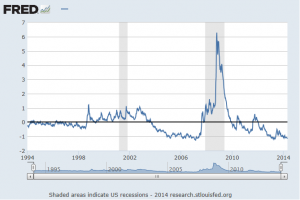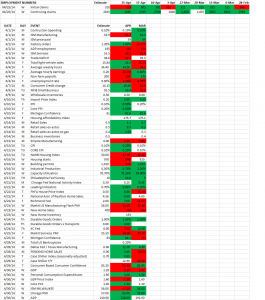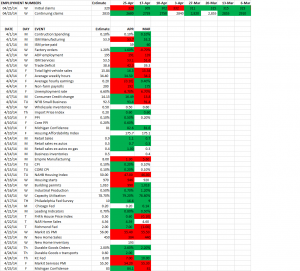Up & Down Wall Street
There has been a big rush to buy long-term government bonds, both here in the US and overseas. Long-term rates priced in higher short terms rates than are likely resulting in a yield curve that is too steep. Thus, yields are now moving lower, the opposite of what all the experts thought would happen. Randall Forsyth writes “investors are flocking to safety in the form of low-yielding bonds and so-called defensive stocks sporting high price-earnings multiples. That the true conundrum.”
Hard to Get
HollyFrontier (HFC) – first quarter profit was cut in half from prior year, shares down 5% last week. HFC refines oil in Permian Basin. 2.4% yield with plenty of cash on balance sheet. 11.3x 2014 earnings. Stock can get to $62 (+26%) according to Edward Westlake of Credit Suisse.
A Cheap Play on Alibaba’s Growth
China Mobile (CHL) trades at 11x estimated earnings. Stock has been flat since 2008. Yield is greater than 4% but might drop slightly this year. EV/CF =3.4 based on estimated EBITDA. Government owns 74%. Has been using a 3G network but now rolling out 4G. Has 62% market share in China.
Alibaba needs high speed 4G for growth. Priced at $48 Bernstein analyst Chris Lane has a $67 price target. Matt Ring at Penza says there is “incredible downside protection from both the low valuation and the significant net cash position.”
Risk is that the cash can end up being used for political projects. Minimal FCF this year due to capex.
What the smartest investors are buying now?
Einhorn is short ATHN and said stock could fall 80% from its recent high. Bill Ackman likes FNMA. Larry Robbins likes HUM and WLP. Philippe Laffont was bullish on LBTYA. Zach Schreiber was bullish on VLO and MPC. Jeff Gundlach is bearish on housing stocks. Jim Grant pushed OGZPY. Chris Shumway likes MCO. Mariko Gordon is bullish on EFII, FUL, PCRX. Columbia student Michael Guichon pitched FIATY, trades at 3x EBITDA. Michael Novograts says Brazil can rally if President Rousseff loses in the election.
Flowserve Sees Big Opportunities to Grow
Shares have tripled since 2011 to $75 and trades at 16.9x 2015 estimates but Lee Caleshu of Roosevelt Investment Group see $5 per share next year at an 18 p/e for a $90 price. Earned $3.41 in 2013. Guidance is for between $3.65 and $4.00 this year on a 3 to 6% increase in revenue.
Two Stocks in the Recovery Zone
Brinks was hit with a $122m write down due to currency devaluation in Venezuela. At $25 trades for an EV of 3.8x EBITDA. Competitor Loomis trades for 7x. Jeff Kessler at Imperial Capital thinks margins can get back to 5 to 6% with earnings rising to $1.90 next year. He has a $27 price target.
Big 5 Sporting Goods (BGFV) is down 44% since last May to $12.07. Hurt by falling gun and ammunition sales. Looking to improve margins and comparisons should start getting easier. Mark Smith of Feltl has a $19 price target.
Healthy Profits in Protein
Farha Aslam of Stephens likes Tyson. “Tyson is managed for consistent growth. They have committed to delivering 10% earnings per-share growth annually and to maintaining a very strong balance sheet.”
“They have an active program in place to buy back 34.6 million shares.”
Aslam also likes Pilgrim’s Price (PPC).



